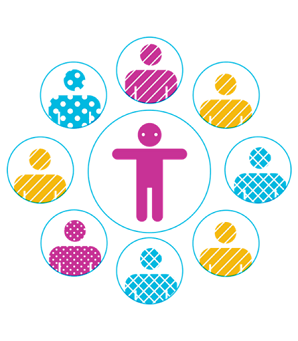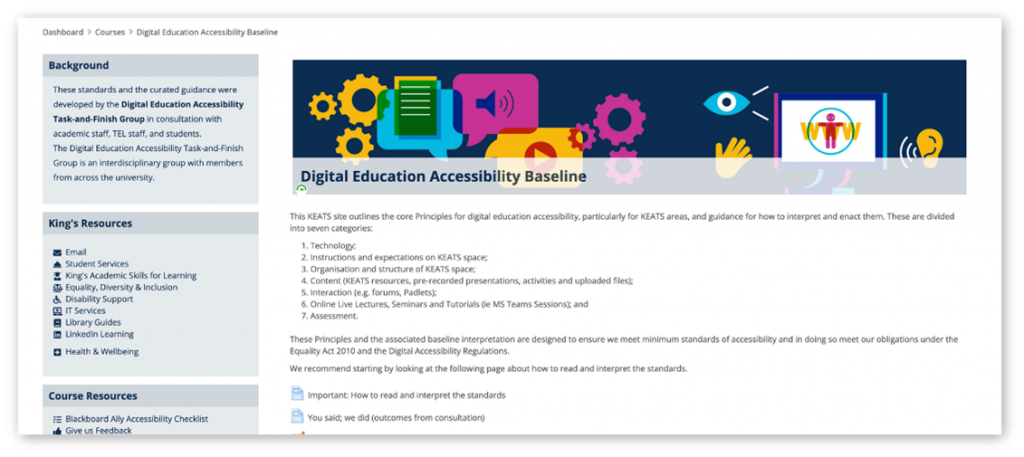When the UK went into lockdown due to the Covid 19 pandemic, King’s College London was forced to close the university and move its courses online. As we were pivoting to learning and teaching online at an unprecedented scale the use of our Virtual Learning Environment, KEATS (Moodle), greatly increased. This focused the spotlight on the web accessibility regulations for public sector bodies. These regulations require public sector websites, intranets (including KEATS) and mobile applications to achieve specific accessibility standards, and reinforced the need for digital accessibility guidance for colleagues developing or uploading resources to KEATS course areas.
Digital accessibility is the ability of a website, mobile application, or electronic document to be easily navigated and understood by a wide range of users, including those users who have visual, auditory, motor or cognitive disabilities. This blog reflects on the process we went through to create a Digital Education Accessibility Baseline, explains how to read and interpret the standards, and provides some tips to help raise our standards for digital accessibility.

 The Digital Education Accessibility Task and Finish Group was an interdisciplinary group with members from across the university, including colleagues from Equality, Diversity and Inclusion, Disability Support, CTEL, King’s Academy, an educator, and a student. The reason for this collegiate approach was to ensure we had appropriate expertise and to take on board the views of all stakeholders. The aim of the group was to enable colleagues to provide inclusive digital education as standard by improving understanding, clarifying expectations, and advocating for enablers.
The Digital Education Accessibility Task and Finish Group was an interdisciplinary group with members from across the university, including colleagues from Equality, Diversity and Inclusion, Disability Support, CTEL, King’s Academy, an educator, and a student. The reason for this collegiate approach was to ensure we had appropriate expertise and to take on board the views of all stakeholders. The aim of the group was to enable colleagues to provide inclusive digital education as standard by improving understanding, clarifying expectations, and advocating for enablers.
The baseline was designed to ensure we meet minimum standards of accessibility and in doing so meet our obligations under the Equality Act 2010 and the Digital Accessibility Regulations. But the benefits are wide ranging, as inclusive design benefits everyone including those with hidden, temporary, and situational disabilities.
A draft of the Digital Education Accessibility Baseline standards, their baseline and aspirational interpretations was shared with focus groups of educators, digital education staff and students. During the focus groups, participants gave feedback on the standards and discussed some of the barriers and enablers of adoption. Taking into account this feedback, we revised the standards and interpretations in various ways including:
- Creating additional flexibility for local decisions
- Including options that considered broader contexts
- Emphasising issues that students highlighted as particularly salient
Some of the feedback provided could not be reflected in the standards themselves. In some cases, this was because those pieces of feedback conflicted with best practices and legislation around accessibility, with feedback from other focus groups, or with existing policy. In other cases, this was because the feedback was more appropriately addressed in other ways.

The Digital Education Accessibility Baseline KEATS site was developed, it outlines the core Principles for digital education accessibility, particularly for KEATS areas, and guidance for how to interpret and enact them. These are divided into seven categories:
- Technology;
- Instructions and expectations on KEATS space;
- Organisation and structure of KEATS space;
- Content (KEATS resources, pre-recorded presentations, activities and uploaded files);
- Interaction (e.g. forums, Padlets);
- Online Live Lectures, Seminars and Tutorials (i.e. MS Teams Sessions); and
- Assessment.
The standards are organised by principle and for each principle, two interpretations are offered:
- The Baseline Interpretation covers the minimum or most straight-forward recommendations for how to interpret these principles.
- For fully online courses and those looking to develop their KEATS area further, there is the Aspirational Interpretation, which presents a “best practice” interpretation of the principles that is more complex and time-intensive and may require additional technical expertise.
In each of the category sections on the curated KEATS site, you will find the relevant principles, the two Interpretations, and related examples, justifications, and guidance for how you can practically meet the standards. The site also includes a search facility for ease of use.
The Office for Students (OFS) example of inclusive practice is to reform a service so that all students have the opportunity to thrive. By adopting the Digital Education Accessibility Baseline, we can all play a part in improving the student digital education experience.
To help you on your journey to raise standards for digital accessibility it is worth noting:
- Utilising accessible templates will support consistency and facilitate good practice.
- It is easier to create accessible content from scratch than update existing content.
- Using the accessibility checker when creating content in Microsoft products will help create accessible content.
- The Blackboard Ally Course Accessibility Report can be used to help fix existing content in KEATS.
Guidance on all the above can be accessed via the Digital Education Accessibility Baseline KEATS site you just need to self-enrol on initial use.
Useful Links
- Digital Education Accessibility Baseline (KEATS site)
- Accessible templates (KEATS page)
- Microsoft accessibility checker
- Blackboard Ally (KEATS site)
- Briefing on accessibility regulations for public sector bodies (PSBAR)
- Applying the Digital Education Accessibility Baseline: An Academic’s perspective – recording (duration 13mins)
Written by Catherine Bone
I am a Learning Technologist (Faculty Liaison) within the Centre for Technology Enhanced Learning (CTEL) at King’s College London. I have a background in teaching and have worked in digital education roles for over twenty years. I have a passion for Technology Enhanced Learning and the opportunities it provides for flexible inclusive learning and teaching.
